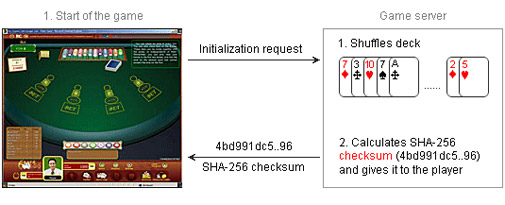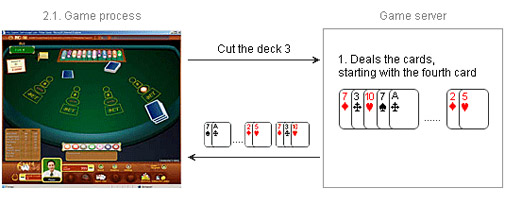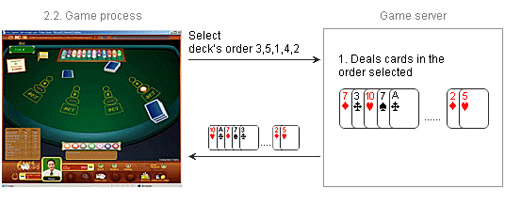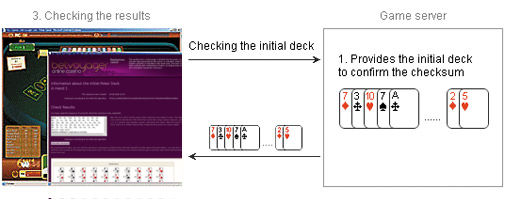FAQ about Randomness Control
Questions:
- Why is Randomness Control necessary?
- How does Randomness Control work?
- Why is necessary to cut the deck or reorder how the cards are dealt?
- Why is there a shift option in roulette, the Wheel of Fortune and the slots?
- What is the server’s key phrase?
- Why is a checksum computed for a single deck, but the checksum for roulette can be computed for up to 60 spins?
- How does RC work in roulette, the Wheel of Fortune and slots?
- What is the checksum and why is it necessary?
- What does the SHA-256 algorithm that RC uses represent?
- What are the principles that are behind the idea of RC?
- Can the casino play against to a player’s bet?
- Can the casino formulate a deck of cards that will deal a losing hand to me?
- Can the casino change a deck or sequence of numbers (in roulette, for example) in the middle of a game?
- Why should I trust the algorithm which RC uses to compute the checksum?
Answers:
Why is Randomness Control necessary?
BetVoyager uses Randomness Control so that you can be absolutely certain that the cards and their arrangement are completely random and have no connection to the size of your bet. Moreover, your can influence the random series that the server generates by cutting the deck or reordering the cards that are dealt.
How does Randomness Control work?
This is best explained with an example. Take a look at the RC process during a game of oasis poker:

At the start of the game, the game server gives you the deck’s checksum, which is computed before the game begins. You can copy or jot down the given checksum and use it at the end of the game to check that it confirms the results.


Before the deal (and before you’ve placed a bet), you can use one of two ways to ensure randomness when the cards are dealt from the already-formulated deck. The first way is to cut the deck (Diagram 2.1) so that the deal begins with the card that comes immediately after the number you’ve picked. In other words, the deck has 52 cards and, if you pick 3, the deal starts with the fourth card. The second method is reordering the cards (Diagram 2.2), in which you create the order in which cards will be dealt from the deck. Numbers in this order should be separated by a comma (or a dash if you’d prefer an unbroken series of numbers), and they represent the numerical order of the cards in the initial deck.
The deck’s checksum doesn’t change when either of these steps is taken. The only thing that changes is the order that the cards are removed from the deck and dealt.
After you’ve decided whether to cut the deck or reorder the cards, you can make your bet and press the Deal button to begin the game.

After the deal is over, the game’s results can be checked. Press the Check Results button and a new window opens that shows the initial deck, its checksum and the cut or reordering the cards, if you used either of those options.
Why is necessary to cut the deck or reorder how the cards are dealt?
You can cut the deck or reorder the cards as additional insurance that the cards are randomly dealt from a deck that was formulated before the hand (this is what we call the “initial deck”). By using the cut or reordering the cards, you control the order that cards are dealt during the game.
Why is there a shift option in roulette, the Wheel of Fortune and the slots?
The shift option for roulette, the Wheel of Fortune and the slots plays the same role as cutting the deck or reordering the cards does in card games. By using the shift option, which adds the selected number of the shift to the initial number, you can be assured that the game’s results are random.
What is the server’s key phrase?
The control phrase is used for casino safety, to ensure that hackers can’t abuse the system. The control phrase doesn’t have any effect on the players.
Why is a checksum computed for a single deck, but the checksum for roulette can be computed for up to 60 spins?
You can use up to 60 spins on roulette to make using the shift option less burdensome. That way, if you want, the shift option can be created once and last for the entire sequence of spins.
In card games, each deck is large enough so that a single deck is enough to prevent misuse by players, such as formulating a large number of decks that negatively effect the server speed.
How does RC work in roulette, the Wheel of Fortune and slots?
Randomness Control for roulette, the Wheel of Fortune and slots works the same basic way as RC for card games. However, in these games RC has a different variable. In them, you decide the number of spins in the sequence before the game starts and you can use the shift option. If you want, you can change the size of the shift every spin, or you can leave the same shift for the entire sequence.
What is the checksum and why is it necessary?
The checksum is a unique thread that is computed by applying predetermined mathematical operations to the entered data (for example, a series of letters and numbers that could represent a deck of cards or the numbers that are spun in roulette). Regardless of the size of the data entered, the checksum is always the same size.
A checksum is usually used to confirm the accuracy during data transfers through communication channels It is used in cryptography as a guarantee that a message hasn’t been changed.
At BetVoyager RC uses the SHA-256 algorithm to determine the checksum.
What does the SHA-256 algorithm that RC uses represent?
SHA-256 is an algorithm that computes checksums that are used in encryption systems and systems to control data transfer. The algorithm guarantees that even the smallest change of the incoming data will completely change the checksum.
You can read more about SHA-family algorithms at Wikipedia here:
What are the principles that are behind the idea of RC?
At the foundation of RC is the principle that the initial deck (for card games) or initial sequence of numbers (for roulette, the Wheel of Fortune and slots) does not change. After the initial deck (or sequence) is formulated and the computed checksum is shown to the player, the deck or the sequence doesn’t change. Players can introduce additional randomness by cutting the deck or selecting the order of the deck (for card games) or by using shift option for roulette, the Wheel of Fortune and slots.
The checksum is used in RC for the same reason it’s used in cryptography: it guarantees that the initial data (the deck of cards or the sequence of numbers) doesn’t change.
Can the casino play against to a player’s bet?
That is categorically impossible.
For card games: First of all, in card games the deck is formulated before you make a bet. After that, it is impossible to change the deck, in as much as it uses a well-known, publicly accessible algorithm to determine the checksum. Any attempt to alter the initial deck would completely change the checksum and be obvious to even first-time players. Secondly, you have the opportunity choose the order the cards are dealt yourself, determining the order cards are drawn.
For roulette, the Wheel of Fortune and slots: In the first place, you can formulate a sequence of numbers that is between 1 and 60 and those numbers can’t be changed during the entire sequence. This is because the algorithm that determines the checksum, and, as written above, any slight changes would totally alter the checksum. Furthermore, you have the opportunity to use the shift option, which can be changed for each spin, in order to introduce additional randomness to the server’s formulated values.
Can the casino formulate a deck of cards that will deal a losing hand to me?
That is categorically impossible.
The casino doesn’t know how many boxes you will play on. Furthermore, if you have any doubt about the randomness of the shuffle, you can select the order of cards you want to receive.
Can the casino change a deck or sequence of numbers (in roulette, for example) in the middle of a game?
That is categorically impossible.
After the deck or sequence of numbers is created, you are given its checksum. At the end of play, you can confirm whether or not the checksum that was given to you corresponds with the deck or sequence of numbers that were displayed during the game. If even a single number were changed during the game, the checksum would change so completely that you would notice immediately.
Why should I trust the algorithm which RC uses to compute the checksum?
Use of the SHA-256 has been permitted by the US government agency .
SHA-256 is the required secure hash algorithm for use in U.S. Federal applications, including use by other cryptographic algorithms and protocols, for the protection of sensitive unclassified information.
Here are several other examples where the SHA-256 algorithm is used:
- For cryptography processors:
- SUN Microsystems uses this algorithm to detect mistakes:
. - Use of this algorithm has been widely written about:
.
Glossary
- Formulated (or initial) deck
- A deck that has been shuffled by the server and which is assigned a checksum that you see at the RC bar at the top of the window
- Formulated (or initial) sequence of numbers
- The number formulated by the server and which is assigned a checksum that you see at the RC bar at the top of the window
- Additional randomness
- You can introduce this during play by cutting the deck or selecting the order of the cards in card games or, in roulette, the Wheel of Fortune and slots, by using the shift option.
- Server’s control phrase
- This is formulated by the casino for safety purposes. It doesn’t have any use or significance for you.
- Checksum
- A unique thread that is computed by applying predetermined mathematical operations on the entered data. Regardless of the size of the data entered, the checksum is always the same size.
- The cut
- The number selected so that the deal begins with the card that comes immediately after it, while all cards before the cut are moved to the end of the deck.
- Selecting the deck’s order
- A selection of numbers (5, 7, 10, 24) or an unbroken series of numbers (2-5,10-15), that are used to create a new order of cards from the initial deck.
- Shift
- A number named by you that shifts the number formulated by the server to determine, for example, the number that comes up on a roulette spin.
- SHA-256
- An algorithm that determines checksums that are used in encryption systems and systems to control data transfer. The algorithm guarantees that even the smallest change of the incoming data will completely change the checksum.































